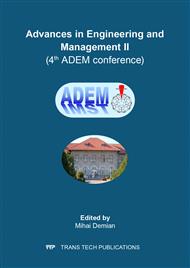[1]
Information on http://www.biomatin.eu/pdf/Regional_analysis_of_the_biomaterial_market.pdf.
Google Scholar
[2]
J. Zhang, C. Huang, Q. Xu, A. Mo, J. Li, Y. Zuo, Bological properties of a biomimetic membrane for guided tissue regeneration: a study in rat calvarial defects, Clin.Oral Implants Res., 21 (2010) 392-397.
DOI: 10.1111/j.1600-0501.2009.01857.x
Google Scholar
[3]
F.D. Burstein, Bone substitutes, Cleft Palate Craniofac. J. 37 (2000) 1-4.
Google Scholar
[4]
R. Schnettler, J.P Stahl, V. Alt, T. Pavlidis, E. Dingeldein, S. Wenisch, Calcium phosphate-based bone substitutes, Trauma 30 (2004) 219-229.
DOI: 10.1007/s00068-004-1393-x
Google Scholar
[5]
M. Okada, T. Furuzono, Hydroxylapatite nanoparticles: fabrication methods and medical applications, Science and Technology of Advanced Materials (2012), 13 (2012), Published online: 28 Dec (2012).
DOI: 10.1088/1468-6996/13/6/064103
Google Scholar
[6]
M. Ozawa, S. Suzuki, Microstructural Development of Natural Hydroxyapatite Originated from Fish-Bone Waste through Heat Treatment, J. Am. Ceram. Soc. 85 (2002) 1315-1317.
DOI: 10.1111/j.1151-2916.2002.tb00268.x
Google Scholar
[7]
G. Sima, I. Cinca, C. Teisanu, O. Gingu, Mechanical characterization of the PM hydroxyapatite-based biocomposites elaborated by two-step sintering, Advanced Materials Research, 1128 (2015) 162-170.
DOI: 10.4028/www.scientific.net/amr.1128.162
Google Scholar
[8]
D.M. Roy, S.K. Linnehan, Hydroxyapatite Formed from Coral Skeletal Carbonate by Hydrothermal Exchange, Nature 247 (1974) 220-222.
DOI: 10.1038/247220a0
Google Scholar
[9]
P. Honarmandi, P. Honarmandi, A. Shokuhfar, B. Nasiri-Tabrizi, R. Ebrahimi-Kahrizsangi, Milling media effects on synthesis, morphology and structural characteristics of single crystal hydroxyapatite nanoparticles, Adv. Appl. Ceram. 109 (2010).
DOI: 10.1179/174367509x12447975734230
Google Scholar
[10]
C. Combes, C. Rey, Amorphous calcium phosphates: Synthesis, properties and uses in biomaterials, Acta Biomater. 6 (2010), 3362-3378.
DOI: 10.1016/j.actbio.2010.02.017
Google Scholar
[11]
G.H. Nancollas, M.S. Mohan, The growth of hydroxyapatite crystals, Arch. Oral. Biol. 15 (1970) 731-745.
DOI: 10.1016/0003-9969(70)90037-3
Google Scholar
[12]
C. Teisanu, G. Sima, Solid-state foaming in two step sintering to produce HAp-based biocomposites for bone grafting in: A. Rotaru (Ed.), Advanced Engineering Ceramics Materials, Applications and Developments for the Medical, Agrochemical and Abrasive Industries, ACADEMICA Greifswald Publishing House, Germany, ISBN 978-3-940237-38-5, 2016, pp: 35-80.
Google Scholar
[13]
I.G. Bucse, C. Ristoscu, B.A. Olei, Structural analysis of PM hydroxyapatite-based composites elaborated by two-step sintering J. Optoelectron. Adv. M., 17 (2015) 1050-1054.
Google Scholar
[14]
I.S. Trakhtenberg, A.P. Rubshtein, E.G. Volkova, S.A. Petrova, A.Y. Fishman, R.G. Zakharov, V.B. Vykhodets, T.E. Kurennykh, Effect of mechanical activation on the morphology and structure of hydroxyapatite, Inorg. Mater. 47 (2011) 45-50.
DOI: 10.1134/s0020168510121052
Google Scholar
[15]
S.Serraj, P. Boudeville, B. Pauvert, A. Terol, Effect on composition of dry mechanical grinding of calcium phosphate mixtures, J. Biomed. Mater. Res. 55 (2001) 566-575.
DOI: 10.1002/1097-4636(20010615)55:4<566::aid-jbm1050>3.0.co;2-f
Google Scholar
[16]
H. El Briak-BenAbdeslam, C. Mochales, M.P. Ginebra, J. Nurit, J.A. Planell, P. Boudeville, Dry mechanochemical synthesis of hydroxyapatites from dicalcium phosphate dihydate and calcium oxide: a kinetic study, J. Biomed. Mater. Res. A 67 (2003).
DOI: 10.1002/jbm.a.10025
Google Scholar
[17]
D. Coman, O. Otat, FEM biomechanical analysis of the skull reconstruction using new advanced biocomposite materials, in A. Rotaru (Ed.), Advanced Engineering Materials. Recent Developments for Medical, Technological and Industrial Applications, ACADEMICA Greifswald Publishing House, Germany, 2016, pp.81-113.
Google Scholar
[18]
M. Nicoara, A. Raduta, C. Locovei, Computerized Image Processing for Evaluation of Microstructure in Metallic Matrix Composites, Solid State Phenomena 188 (2012) 124-133.
DOI: 10.4028/www.scientific.net/ssp.188.124
Google Scholar
[19]
C. Suryanarayana, Mechanical alloying and milling, Progress in Materials Science 46 (2001) 1-84.
Google Scholar
[20]
I. Kerr, Metal Powder Rep. 48 (1993), 36-8.
Google Scholar
[21]
S.M. Seo, D.M. Kim, T.J. Chung, J.J. Yoo, H.J. Kim, H.J. Chun, J.W. Jang, K.S. Oh, Effect of milling time on the viscosity of hydroxyapatite suspension, Current Applied Physics 12 (2012) S71-S75.
DOI: 10.1016/j.cap.2012.02.023
Google Scholar
[22]
H. El Briak-BenAbdeslam, M.P. Ginebra, M. Vert, P. Boudeville, Wet or dry mechanochemical synthesis of calcium phosphates? Influence of the water content on DCPD–CaO reaction kinetics, Acta Biomaterialia 4 (2008) 378–386.
DOI: 10.1016/j.actbio.2007.07.003
Google Scholar
[23]
R.M. Davis, B. McDermott, C.C. Koch, Mechanical alloying of brittle, Metall Trans A. A19 (1998) 2867-2874.
Google Scholar
[24]
R. Othman, A. Zakaria, Optimization of milling parameters during mechanical activation for direct synthesis of hidroxyapatite, ASEAN Engineering Journal, 1 (2001) 5-11.
Google Scholar
[25]
C.C. Koch, Materials synthesis by mechanical alloying, Annu. Rep. Mater. Sci. 19 (1989) 121-142.
Google Scholar
[26]
R.Z. LeGeros, G. Bonel, R. Legros R, Types of H2O, in human enamel and in precipitated apatites, Calcif Tissues Res. 26 (1978) 111-118.
DOI: 10.1007/bf02013245
Google Scholar
[27]
R.A. Young, D.A. Holcomb, Role of acid phosphate in hydroxyapatite lattice expansion, Calcif. Tissue. Int. 36 (1984) 36:60-63.
DOI: 10.1007/bf02405294
Google Scholar
[28]
R.B. Schwarz, Introduction to the viewpoint set on: mechanical alloying. Scrip. Mater. 34 (1996) 1-4.
Google Scholar
[29]
Shen TP, Koch CC, McCormick TL, Nemanich RJ, Huang JY, Huang JG., The structure and property characteristics of amorphous/nanocrystalline silicon produced by ball milling. J. Mater. Res. 10 (1995) 139-148.
DOI: 10.1557/jmr.1995.0139
Google Scholar
[30]
N.N. Thadhani, Shock-induced and shock-assisted solid-state chemical reactions in powder mixtures. J. Appl. Phys. 76 (1994) 2129-2138.
DOI: 10.1063/1.357624
Google Scholar
[31]
M. Nicoara, C. Locovei, C. Opris, D. Ursu, R. Vasiu, M. Stoica, Optimizing the parameters for in situ fabrication of hybrid Al-Al2O3 composites, J. Therm Anal Calorim. Published online: june 17, (2016).
DOI: 10.1007/s10973-016-5595-3
Google Scholar


